
The standard circulating coinage of the United Kingdom, British Crown Dependencies and British Overseas Territories is denominated in pennies and pounds sterling, and ranges in value from one penny sterling to two pounds. Since decimalisation, on 15 February 1971, the pound has been divided into 100 (new) pence. Before decimalisation, twelve pence made a shilling, and twenty shillings made a pound.
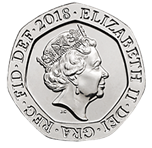
The British decimal twenty pence coin is a denomination of sterling coinage worth 1⁄5 of a pound. Like the 50p coin, it is an equilateral curve heptagon. Its obverse has featured the profile of Queen Elizabeth II since the coin's introduction on 9 June 1982. Four different portraits of the Queen have been used; the latest design by Jody Clark was introduced in 2015. The second and current reverse, featuring a segment of the Royal Shield, was introduced in 2008.
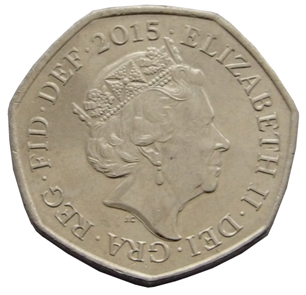
The British decimal fifty pence coin is a denomination of sterling coinage worth 1⁄2 of one pound. Its obverse features the profile of the current Monarch since the coin's introduction in 1969. As of October 2022, five different royal portraits have been used.
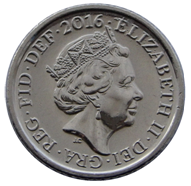
The British decimal five pence coin is a denomination of sterling coinage worth 5⁄100 of a pound. Its obverse has featured the profile of Queen Elizabeth II since the coin’s introduction on 23 April 1968, replacing the shilling in preparation for decimalisation in 1971. It remained the same size as the one shilling coin, which also remained legal tender, until a smaller version was introduced in June 1990 with the older coins being withdrawn on 31 December 1990. Four different portraits of the Queen have been used, with the latest design by Jody Clark being introduced in 2015. The second and current reverse, featuring a segment of the Royal Shield, was introduced in 2008.

The British decimal ten pence coin is a denomination of sterling coinage worth 1⁄10 of a pound. Its obverse has featured the profile of Queen Elizabeth II since the coin's introduction in 1968, to replace the florin coin in preparation for decimalisation in 1971. It remained the same size as the florin coin until a smaller version was introduced 30 September 1992, with the older coins being withdrawn on 30 June 1993. Four different portraits of the Queen have been used on the coin; the latest design by Jody Clark was introduced in 2015. The second and current reverse, featuring a segment of the Royal Shield, was introduced in 2008.

The British decimal two pence coin is a denomination of sterling coinage equalling 2⁄100 of a pound. Since the coin's introduction on 15 February 1971, the year British currency was decimalised, its obverse has featured four profiles of Queen Elizabeth II. In 2008 the design on its reverse changed from the original depiction of a plume of ostrich feathers with a coronet to a segment of the Royal Shield.

The British decimal halfpenny coin was a denomination of sterling coinage introduced in February 1971, at the time of decimalisation, and was worth 1⁄200 of one pound. It was ignored in banking transactions, which were carried out in units of 1p.

The British penny, a large, pre-decimal coin which continued the series of pennies which began in about the year 700, was struck intermittently during the 20th century until its withdrawal from circulation after 1970. From 1901 to 1970, the obverse of the bronze coin depicted the monarch who was reigning at the start of the year. The reverse, which featured an image of Britannia seated with shield, trident, and helm, was created by Leonard Charles Wyon based on an earlier design by his father, William Wyon. The coins were also used in British colonies and dominions that had not issued their own coins.

The British florin, or two-shilling piece, was a coin worth 1⁄10 of one pound, or 24 pence. It was issued from 1849 until 1967, with a final issue for collectors dated 1970. It was the last coin circulating immediately prior to decimalisation to be demonetised, in 1993, having for a quarter of a century circulated alongside the ten-pence piece, identical in specifications and value.

The British farthing abbreviated qua., was a denomination of sterling coinage worth 1/960 of one pound, 1/48 of one shilling, or 1/4 of one penny; initially minted in copper and then in bronze, which replaced the earlier English farthings. Before Decimal Day in 1971, Britain used the Carolingian monetary system, wherein the largest unit was a pound sterling of 20 shillings, each of 12 pence. Each penny was divided into 4 farthings, thus, a pound sterling contained 960 farthings, and a shilling contained 48 farthings. From 1860 to 1971, the purchasing power of a farthing ranged between 12p and 0.2p in 2017 values.

The British threepence piece, usually simply known as a threepence, thruppence, or thruppenny bit, was a denomination of sterling coinage worth 1⁄80 of one pound or 1⁄4 of one shilling. It was used in the United Kingdom, and earlier in Great Britain and England. Similar denominations were later used throughout the British Empire and Commonwealth countries, notably in Australia, New Zealand and South Africa.

Decimal Day in the United Kingdom and in Ireland was Monday 15 February 1971, the day on which each country decimalised its respective £sd currency of pounds, shillings, and pence.
The pound is the currency of Guernsey. Since 1921, Guernsey has been in currency union with the United Kingdom and the Guernsey pound is not a separate currency but is a local issue of sterling banknotes and coins, in a similar way to the banknotes issued in Scotland, England and Northern Ireland. It can be exchanged at par with other sterling coinage and notes.

Coins of the Indian rupee (₹) were first minted in 1950. New coins have been produced annually since then and they make up a valuable aspect of the Indian currency system. Today, circulating coins exist in denominations of One Rupee, Two Rupees, Five Rupees, Ten Rupees and Twenty Rupees. All of these are produced by four mints located across India, in Kolkata, Mumbai, Hyderabad, Noida.
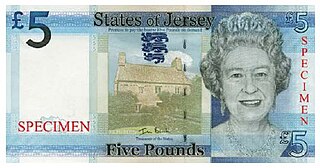
The pound is the currency of Jersey. Jersey is in currency union with the United Kingdom, and the Jersey pound is not a separate currency but is an issue of banknotes and coins by the States of Jersey denominated in sterling, in a similar way to the banknotes issued in Scotland and Northern Ireland. It can be exchanged at par with other sterling coinage and notes.
The pound is the currency of the Isle of Man, at parity with sterling. The Manx pound is divided into 100 pence. Notes and coins, denominated in pounds and pence, are issued by the Isle of Man Government.

The British sixpence piece, sometimes known as a tanner or sixpenny bit, was a denomination of sterling coinage worth 1⁄40 of one pound or half of one shilling. It was first minted in 1551, during the reign of Edward VI, and circulated until 1980. The coin was made from silver from its introduction in 1551 until 1947, and thereafter in cupronickel.

Christopher Ironside OBE, FRBS was an English painter and coin designer, particularly known for the reverse sides of the new British coins issued on decimalisation in 1971.

The Australian sixpence circulated from 1910 up until the decimalisation of Australian Currency in 1966. The coins were initially minted in England; however, Australia began to mint their own from the year of 1916 at branches of the Royal Mint in Sydney and Melbourne. The coins which made up Australia's pre-decimal currency were identical to British currency in the characteristics of weight and size. The Coinage Act of 1909–1947, authorised the issue of Australian coins in the select denominations, including the sixpence. By 1916 all silver denominations, including the sixpence, could be minted at the Royal Mint branch in Melbourne. Unique Australian currency was created with decimalisation in 1966.
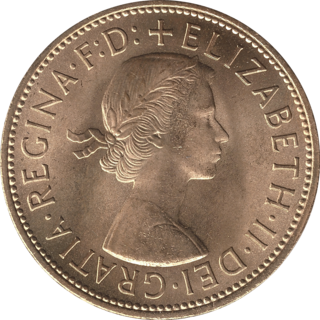
The British pre-decimal penny was a denomination of sterling coinage worth 1⁄240 of one pound or 1⁄12 of one shilling. Its symbol was d, from the Roman denarius. It was a continuation of the earlier English penny, and in Scotland it had the same monetary value as one pre-1707 Scottish shilling. The penny was originally minted in silver, but from the late 18th century it was minted in copper, and then after 1860 in bronze.





















